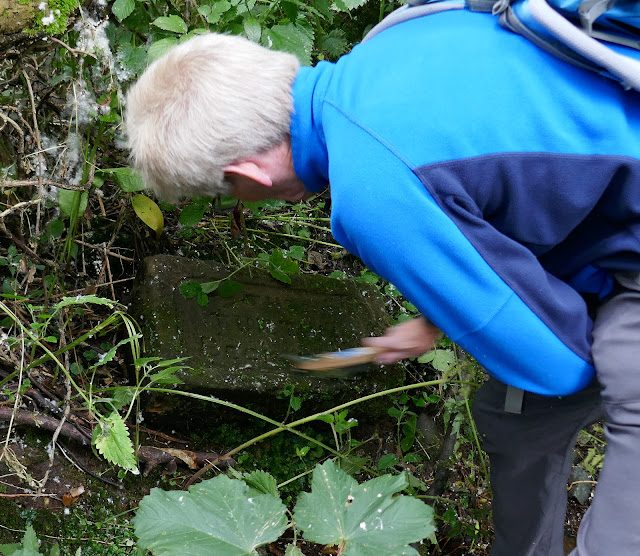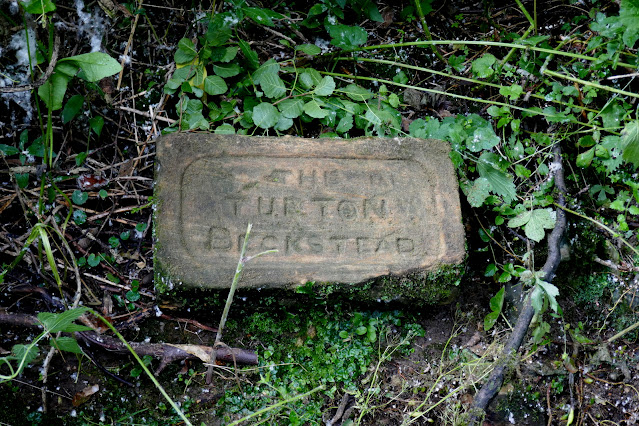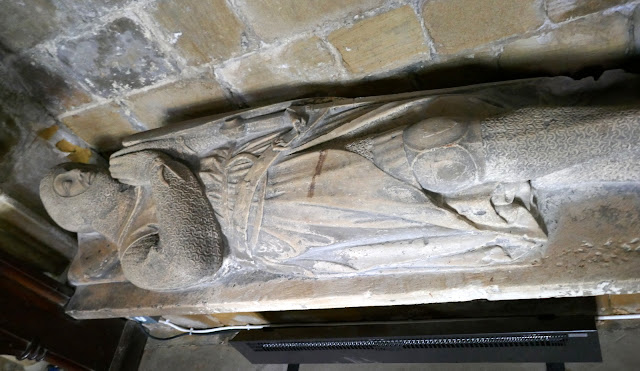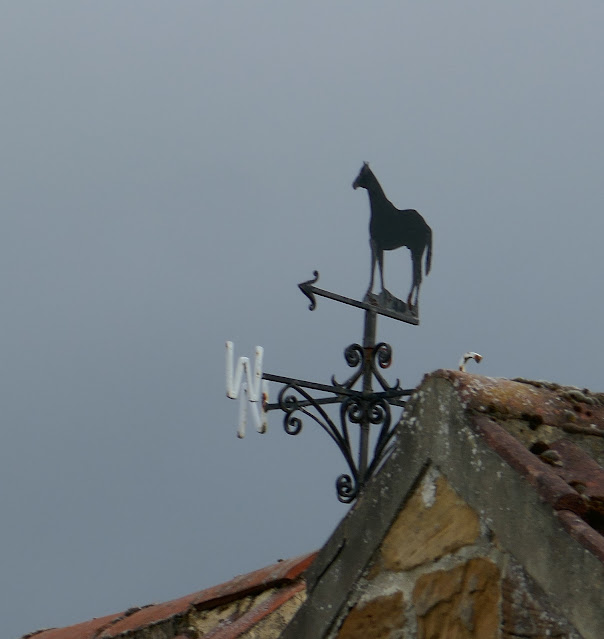Tom Scott Burns relates a strange event that apparently happened here. In the 1860s some mourners were carrying a body from Felixkirk to Kirby Knowle for burial. The bearers set down the coffin to rest briefly at this spot, but on raising it up again it felt much lighter and they discovered that the corpse had disappeared. The empty coffin was buried and the site at Beckstead Wood became known as Lost Corpse End.
It is a fact that bodies were carried by this route from Felixkirk to Kirby Knowle for burial, so that much at least is true.
Leaving Turton Beckstead we climbed gently over Carr Hill to approach the village of Felixkirk through the overgrown fields.
 |
| More bean fields, no margin left for right of way |
 |
| This made us chuckle, it was impossible to cross this stile as the barbed wire is much higher than one's inseam! We had to improvise... |
 |
| Nevison Beckstead |
 |
| Another tricky stile, this time dropping down onto a rotten timber over a stream |
 |
| .. and then a climb through undergrowth |
 |
The houses of Felixkirk appear in the distance
|
We reached the tarmac road at Mount View and turned right to walk into Felixkirk and the church of St Felix which we found to be unlocked. The most striking feature is the domed roof. There are only six churches dedicated to St Felix in the UK. He was a 7th century monk from Burgundy who converted the kingdom of East Anglia to Christianity. The use of the name suggests there has been a church here since Saxon times. The church was restored in 1860 but much of the stonework is original and dates to the 12th century.
 |
| St Felix Church, Felixkirk |
 |
| The unusual domed roof |
 |
| A Lady and her Knight lie near the altar |
 |
| Those underlined died in combat |
 |
Graffitti or mason's name? 'Thomas Carlton 1629' on door arch
|
|
 |
| Ther mouseman of Kilburn has provided the church gate |
As always we paid our respects at the grave of tragic Hannah Cornforth, who died at 21 and has possibly the saddest epitaph we've seen.
 |
Hannah Cornforth 'Twenty years I was a maid, 1 year I was a wife. 18 hours a mother, and then departed life'
|
Retracing our steps to the road junction we turned right and climbed the lane to pass the lodge to Mount St John, famous for its equestrian centre and gardens. Shortly afterwards we turned right off the road and onto a farm track that we followed towards Cinque House, but here the track diverts from TSB's map above, as it has been re-routed around the rear of Cinque House, across a sheep field.
In fact the sheep field was extremely full of sheep today but we resolved to stop here, sheltered from the breeze by Cinque House and its hedges, to enjoy our coffee and scones with a fine view over towards Boltby Scar.
 |
| Mount St John Lodge |
 |
| Leaving the road at the farm gate |
 |
Always lots of horses in these fields
|
 |
| Our path is diverted through fields as we approach Cinque House.. |
 |
| ... into a sheep field |
 |
| ..where we pause for coffee and scones |
 |
| A buzzard checks us out as we dine |
 |
| Cinque House |
We set off once more and our diversion rejoined the track below Cinque Cliff House to follow a grassy lane to the road, where we turned left and walked into Thirlby.
Thirlby is a very pretty village and the road is bordered with neat rural cottages. One of these, Keepers Cottage, has a roadside stall which sometimes sells home made jam, but today offered only free range eggs.
 |
| Weather vane at Thirlby |
 |
| Keepers Cottage |
A point of interest is that Alf White, aka James Herriot, lived in Thirlby and today we were on a mission to find a plaque dedicated not to Herriot but to his boss Seigried Farnon, or Donald Sinclair as he was really named.
Thanks to Steve for information about this plaque. We eventually found it near to the village hall and almost obscured by ivy. Clive took his brush to it and all is revealed once more.
 |
| No mention of his alter-ego Seigfried Farnon |
Walking down the high street we came to Pear Tree House where Thirlby's own woodcarver lives; Bob Hunter, who worked with Mouseman Thompson at nearby Kilburn, and whose trademark is the wren.
 |
| Pear Tree House |
We continued along the lane through the village, crossed the ford and left the tarmac at Thirlby Farm, turning left to follow a track through a grassy meadow.
 |
| Pretty Gurtof Beck at Thirlby |
 |
'No shop or inn is there here about, so why not sit down and enjoy summat for nowt' - donated by 'two good sorts in memory of Bill'. The memorial bench has the wren emblem
|
|
 |
| Leaving Thirlby |
We followed our path, sometimes across fields and sometimes through trees, steadily approaching Boltby.
At Boltby we turned left at the packhorse bridge and walked through the pretty village before turning right at a waymarked sign at the lane between Spring Garth and Gurtof House.
 |
| The packhorse bridge at Boltby |
 |
| Cottage in Boltby |
We followed a series of field boundaries to reach the modern mansion of Ravensthorpe Manor, which we climbed above into Westow Plantation. Here we followed a muddy track behind Ravensthorpe Manor, which was now invisible to us because of the plantation's trees.
There is no pub in Kirby Knowle but a short drive took us to Osmotherley where we discussed today's walk.

















































































































